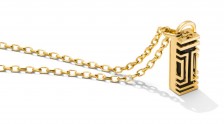Article: Fast Company Master of Design issue features Femme Den
Forget “Shrink It and Pink It”: the Femme Den Unleashed, by Kate Rockwood for Fast Company.
Boobs. The Femme Den talks about them easily and often — and about the challenges they present to designers. Backpack makers don’t seem to have a clue what to do about boobs. Ditto designers of unisex hospital scrubs, famous for their gaping V-necks. “One surgeon told me there wasn’t a woman at the hospital whose boobs he hadn’t seen,” says Femme Den member Whitney Hopkins.
A design engineer at Smart Design, Hopkins is also one of four members of the Den, an internal collective at the firm that’s devoted to thinking about the bodies and brains of women and how to design — smartly — for them. I ask the group, which consists of Hopkins, Agnete Enga, Erica Eden, and Yvonne Lin, if that means razors and sports bras or if it means rethinking everything. “Both,” they answer in unison, from a nook of Smart’s loftlike Chelsea offices. Women are not a niche market, they insist (“No one likes to be targeted,” sniffs Eden), but companies should also be careful not to confuse equality with sameness.
“When most people think of designing for women, they automatically think of tampons and birth control,” Lin says. (It doesn’t help that in industrial design, females make up just 20% of the field.) “Even when a lot of companies think that a product is for both genders, in reality they’re just designing for men. Design is male-biased. Designers are working with male procedurals, probably going back to the beginning of time.” Now, the Femme Den is looking to inject some femininity into those procedurals, everywhere from U.S. Army bases to Target, BP, and Nike.
Like most things at 30-year-old, 130-member Smart Design, the Femme Den bubbled up from an interesting problem. In 2005, Nike’s women’s watches weren’t hitting sales expectations. The all-male design team hired two Smart female staffers (they would become founding members of the Den), who discovered that Nike’s target demographic was begrudgingly opting for clunky men’s watches because they offered more athletic features. When Nike beefed up its women’s watches’ capabilities and fine-tuned a sleek, sporty aesthetic, sales quickly boosted. “It was eye-opening,” says Enga.
As the group took shape, Smart Design cofounder Dan Formosa (affectionately dubbed “Femme Dan”) encouraged the women to “think radically.” They began gathering on weekends, eventually taking their name from a cheekily labeled file folder. When the Femme Den was accepted to the International Conference for Universal Design, in Kyoto, Japan, in 2006, the underground gaggle came out to the world.
The Femme Den isn’t a separate division at Smart Design. Instead, Hopkins, Enga, Eden, and Lin work on shifting teams, deliver in-house presentations, write white papers, and infuse the firm with their ideas. And as more companies realize the potential in the female market — a recent study showed that women influence 80% of household purchases — the group is added ammunition for attracting clients. “If you talk about the differences between men and women at a corporate human-resources meeting, you’d be fired or sent to diversity training,” Formosa says. “But when we cover that same ground with large corporations, the discussion just lights up. There is so much need there, it hits a nerve.”
Companies recognize the need, but most are clumsy — if not patronizing — in their attempts to address it. This often leads to what the Femme Den calls the “shrink it and pink it” reflex, the kind of mindless design that produces such works of genius as mini pink tool kits and Dell’s pastel-saturated Della Web site, stocked with tips about “finding recipes” and “counting calories.” (Dell dumped Della within two weeks of its launch.) What women really want, the Femme Den argues, is intuitive design. In a Yale University study, 68% of men asked to program a VCR using written instructions were successful, compared to just 16% of women. That doesn’t mean women are less intelligent than men (please), but that they’re less tolerant of complicated interfaces — more willing to skip new tech than to slog through manuals. “Men will walk into an electronics shop and look at the white cards that list the features. Women will pick up the cameras, flip them around, and look at the buttons,” Lin says. “They want to know: Is it intuitive?”
At the Consumer Electronics Show in 2006, only 1% of women surveyed felt gadget makers have them in mind during the design process. But when women are factored in, everyone — including businesses — can benefit. When Pure Digital Technologies hired Smart Design to craft a camcorder, the Femme Den members of the team urged Pure Digital to put ease-of-use at the top of its priority list. The Flip camera, with just seven buttons despite its brawny tech, sold 1.5 million units in its first 18 months and drove Cisco’s $590 million acquisition of Pure Digital earlier this year. Men love the Flip too, by the way.
Beyond the electronics aisle, Femme Denners say women are more tuned in to the entire message of a product, from store environment to the social causes it supports, how it fits into a home, and which family members will use it. And physically — surprise, surprise — they’re not simply miniature men. After speaking at the Outdoor Retailer Show last year, the Femme Den tested a slew of survival gear for the U.S. Army and presented their findings to the brass. The unisex equipment was built with broad-shouldered men in mind — a major flaw, considering that 14% of soldiers are female and not all males are G.I. Joe. “When we put on the backpack, we couldn’t even swing our arms because the metal frame was so wide,” says Hopkins.
Of course, the Den wants its ideas to permeate everything from lawn mowers and desk lamps to cell phones and survival gear. But as the young group gains traction, some of the first companies to seek their expertise have understandably been those with more female consumers.
“The Femme Den is more mindful of the deeper meaning of designing for women,” says Craig Sampson, a 20-year Ideo veteran and currently chief innovation officer at World Kitchen. Sampson says the Femme Den’s role within Smart Design was a major factor in his decision to hire the firm to help him expand Pyrex into rangetop cookware. Focused on minimizing cleanup for the multitasking cook, the Den incorporated built-in spoon and lid rests into the new line. “They don’t just understand our products,” Sampson says. “They understand how our brands fit into women’s lives.”
Or how some products don’t. When Cardinal Health, the $99.5 billion health-care-supply company, wanted to rethink the design of hospital scrubs in 2007, balancing the needs of both sexes helped set its product apart. “Probably 70% of the health-care population wearing scrubs is female,” says Carl Hall, Cardinal’s director of marketing. “But scrubs are really designed for men. Smart Design identified the gender thing early on as an opportunity and helped us really evolve that.” Endura scrubs, introduced in March, swapped out V-necks for stretch collars, and added straps and snaps to make the hem and rise adjustable, breathable mesh at the back and knees, as well as a kimono sleeve to increase range of motion.
And that unisex cut? “We used the female form for measurements, so the fabric doesn’t strain across the bust and hips,” Hopkins says. “Men don’t even notice the extra room.” Cardinal has already fed two new projects to Smart Design and the Femme Den.
Not noticing, the Femme Denners say, is the point: Good products balance the needs of men and women for the benefit of both. They’re not male products masquerading as unisex or — worse — hiding under a coat of pink paint. They don’t alienate anyone with overt claims of being women-focused or women- friendly. They just are.
Originally posted on Fast Company.





